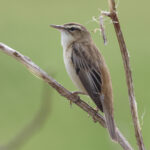A Private Tour today, with a difference. We were particularly targeting certain species and hoping to get photographs of them too. It was a lovely sunny day, warm out of the breeze which picked up on the coast in the afternoon. Perhaps a little too nice?
After a relaxed start, the target for the first part of the morning was to look for raptors. As we drove along, a Red Kite circled over the road, together with a Common Buzzard. We parked at the start of a farm track and walked up to the top of a rise, from where we could get a good view over the surrounding countryside.
We saw a good selection of birds of prey from our vantage point here. First, a Kestrel flew past as we walked along the track. Looking back towards the meadow where we had parked, a Barn Owl was out hunting, presumably still with hungry young in the nest to feed and having to work hard accordingly. As the air warmed, several Common Buzzards circled up out of the trees. Unfortunately, the warming air also meant that the heat haze quickly increased, making photography rather more challenging!
There were other birds too. Best of them all, a Yellow Wagtail flew over calling. They were once more common but are now very scarce in the breeding season across most of Norfolk. One or two pairs cling on in farmland and hopefully this one is breeding somewhere around here. Some distinctive calls alerted us to five Mediterranean Gulls circling high overhead, presumably looking for a suitable field to feed in. Skylarks fluttered up over the fields singing and a Common Whitethroat flitted about in the hedge.
When we had had our fill of raptors, we walked back to the car. Our destination for the rest of the morning was up on the Heath. A particular target here was Garden Warbler. They can be very elusive, often lurking deep in the bushes, but have at least started singing more again in the last week or so, presumably between broods. As we pulled up in the car park, we could hear a Garden Warbler singing but we were pleasantly surprised to look over and see it perched out on the near edge of the blackthorn, close by.
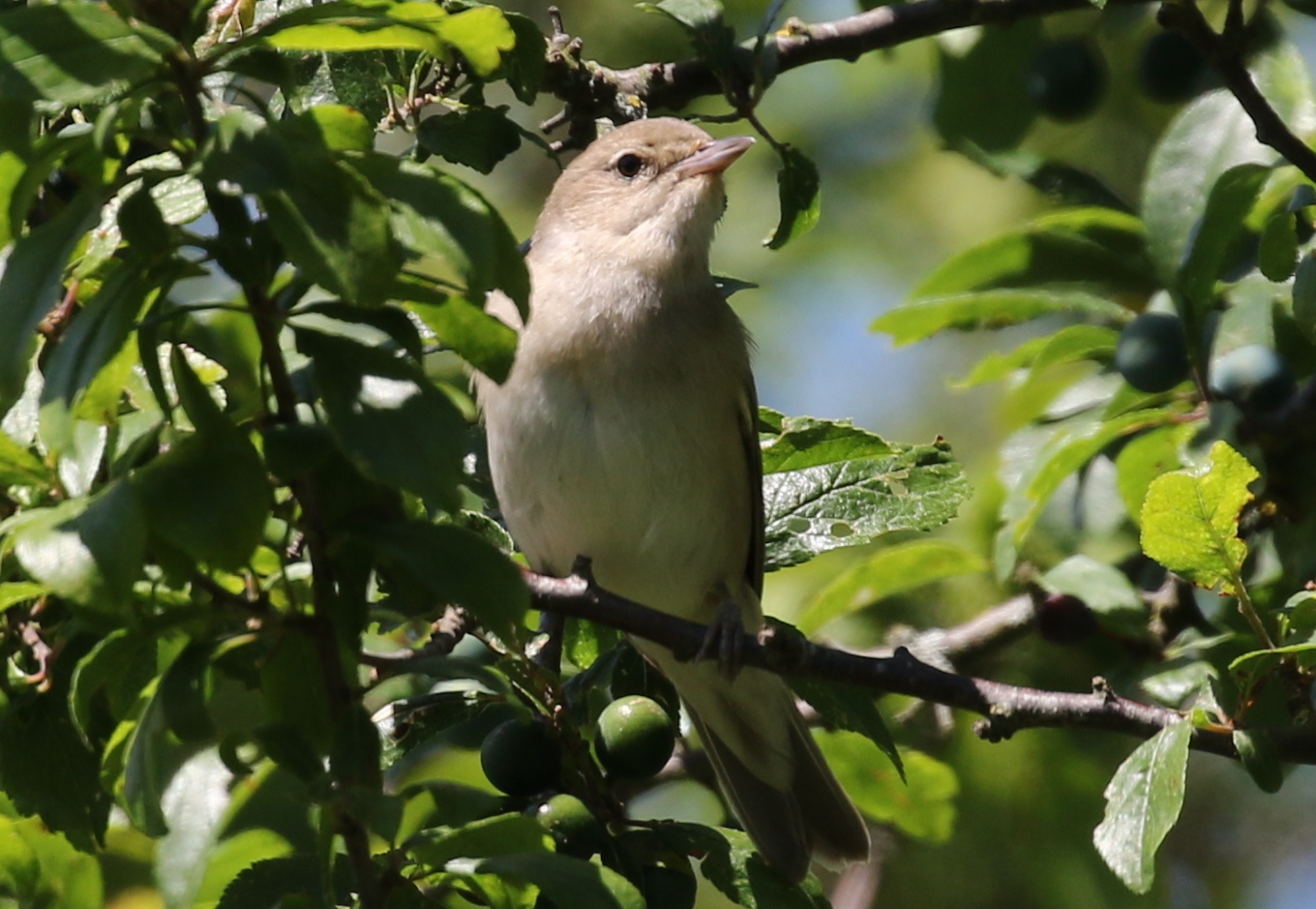 Garden Warbler – posing for the cameras in the car park
Garden Warbler – posing for the cameras in the car park
Having posed unusually well at first, the Garden Warbler quickly dropped back down into cover. Normal service was resumed – we could still hear it singing but from deep in the blackthorn! Still, it was a great start and we set off out onto the Heath feeling rather hopeful.
Our second target here today was Woodlark. Unfortunately, they were not quite so accommodating. They are onto their second broods now and, with the females probably on eggs, they are not at their most visible. Getting towards the middle of the day, it was also not the best time to look for them. When we set off from the car park, we met some other local birders returning who told us they had seen a pair of Woodlarks earlier. We went straight round to the place where they had been, but we couldn’t find them – presumably they had flown off already. We did find a pair of Skylarks feeding nearby, which was not quite what we were looking for, even if very nice to see close to on the ground.
We had a walk round to another area where the Woodlarks have been feeding often in recent weeks, but the vegetation here is growing up fast now making them harder to see. We listened as we circled round the area, but we couldn’t hear any either. There were plenty of Linnets around the gorse and several Yellowhammers singing, although even these were not posing for the cameras quite as they might normally have done today. A couple of juvenile Stonechats were flitting around the bushes out in the middle of the Heath.
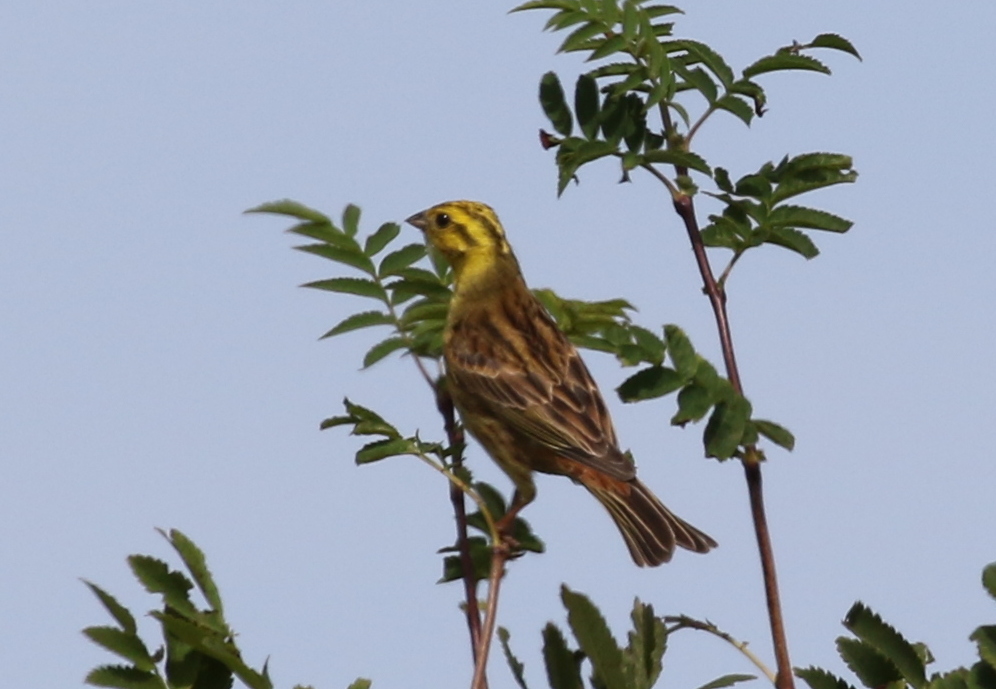 Yellowhammer – there were several males singing around the Heath today
Yellowhammer – there were several males singing around the Heath today
The butterflies were more obliging. There are large numbers of Silver-studded Blues out at the moment, one of the specialities of the Heath, so we stopped to admire a couple of them on our way round.
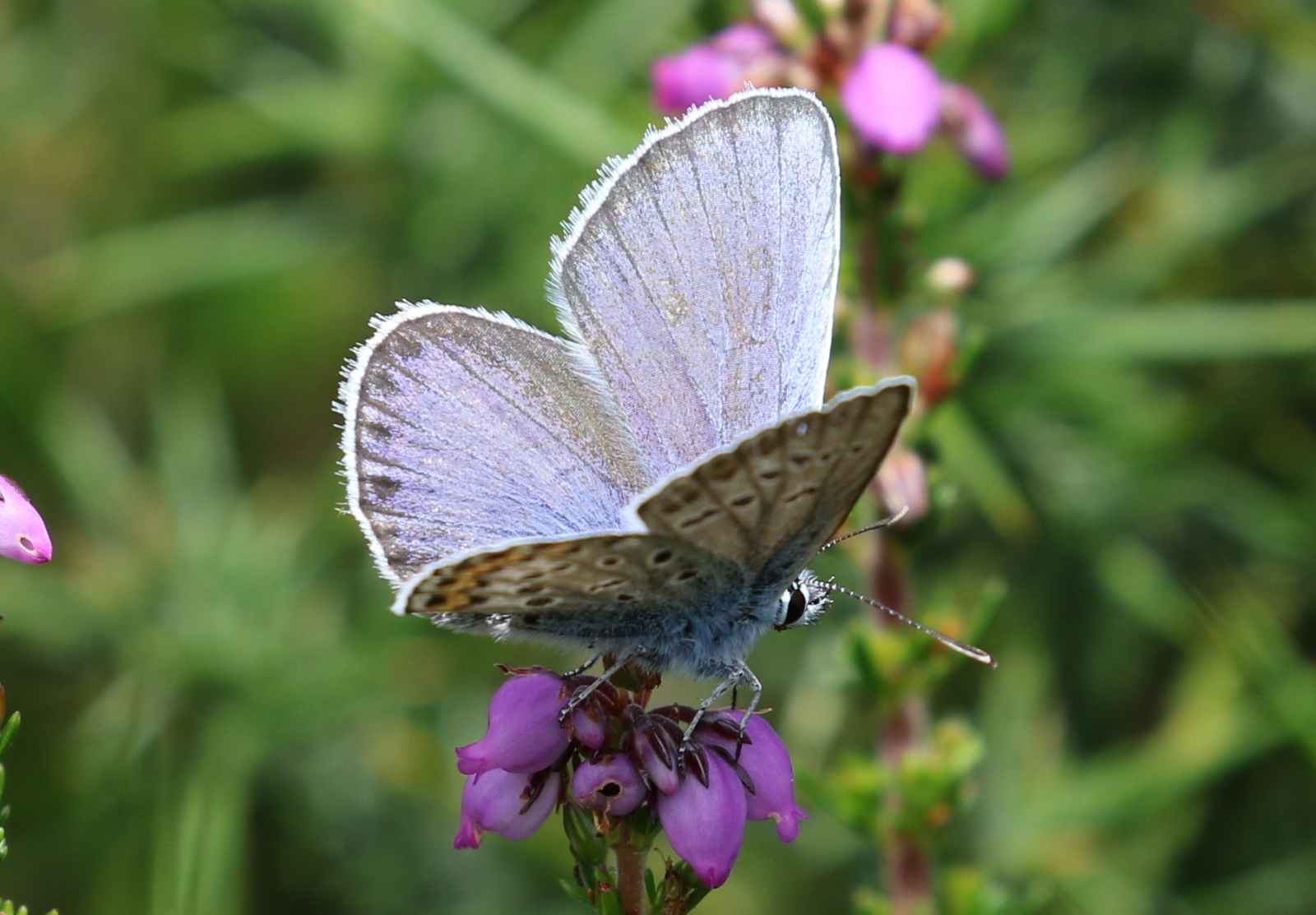 Silver-studded Blue – large numbers are out on the Heath at the moment
Silver-studded Blue – large numbers are out on the Heath at the moment
There wasn’t much time to explore the Heath before it was time for lunch, so we walked back to the car for a break. Typically, we were just in the process of eating our sandwiches in a shady spot when we noticed a couple of Woodlarks flying in low over the trees. They dropped down out of view in the distance and we had a pretty good idea the area where they were heading. We quickly put our food down and grabbed our gear.
We couldn’t see them at first when we got round to the place where the Woodlarks had gone down, so we weren’t sure if they had continued on or landed. We followed the path up a slight rise, and unfortunately they flew up without calling from the far side just as we appeared over the top, three of them. They didn’t go far, but landed again in the long grass just a short distance ahead of us. We could see one of them through the scope, creeping around in the grass.
The Woodlarks were a bit far for photographs, particularly with the heat haze today, so we decided to try to circle round to the other side of them. They can be very obliging, but not today and as we edged forwards they were off again.
After finishing our lunch, we set off again around the Heath to see if we could find any Dartford Warblers. It was early afternoon now, the warmest part of the day, but we hoped a light breeze would be enough to encourage the birds into some activity. It was not the case. Like the Woodlarks, the Dartford Warblers are on second broods now and the females are on eggs. The males still often sing now, but early and late are definitely best.
We did hear a Turtle Dove purring in the trees, but as it was not a target species for the day we did not go off looking for it. We also bumped into a nice selection of insects. As well as the Silver-studded Blues, there were lots of other butterflies, especially lots of Small Skippers feeding on the Viper’s Bugloss. A large Emperor Dragonfly was hawking around other heather. And we saw several bright Green Tiger Beetles on the paths.
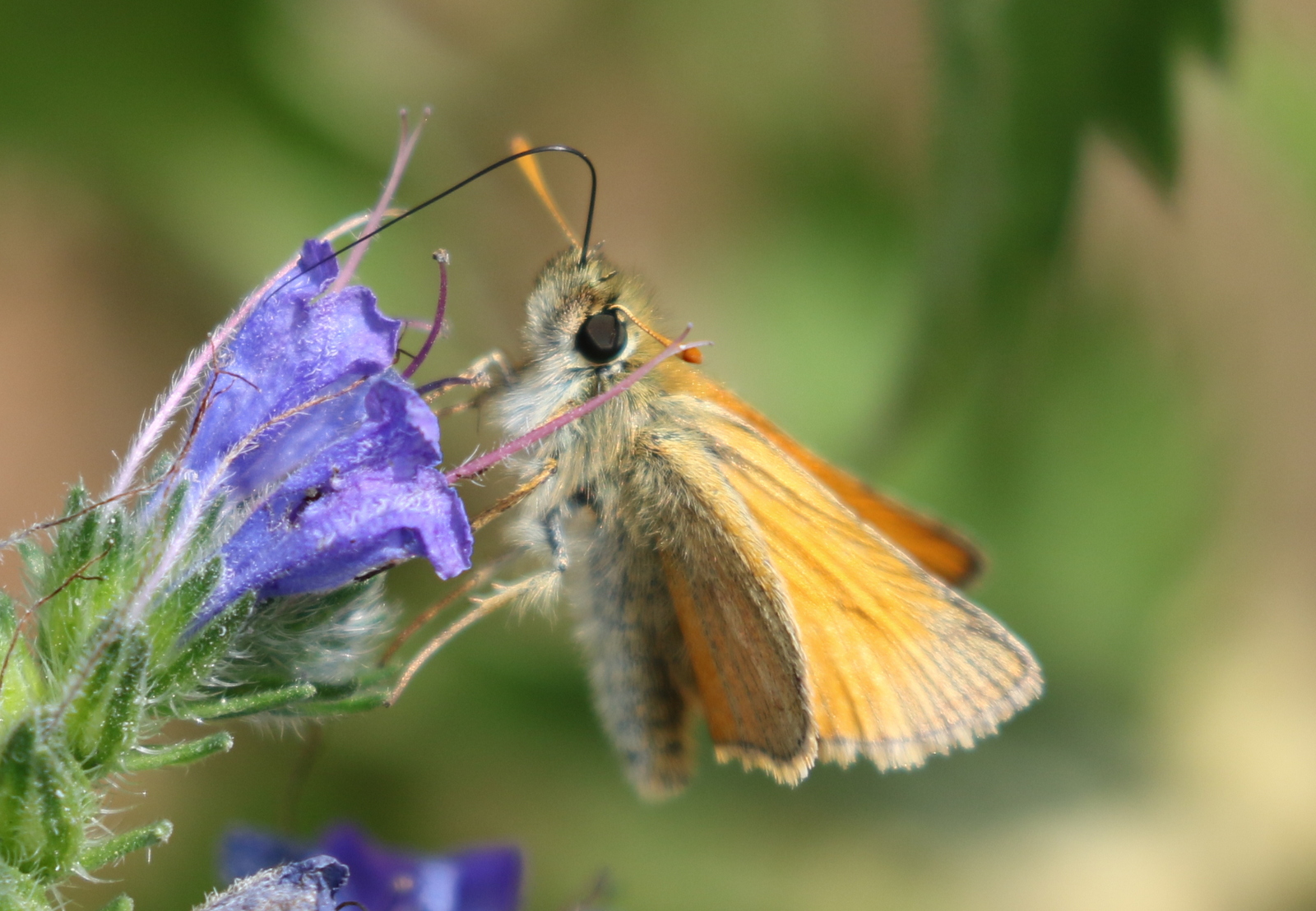 Small Skipper – feeding on Viper’s Bugloss
Small Skipper – feeding on Viper’s Bugloss
With no further sign of the Woodlarks either, we decided to head down to the coast at Cley for a walk. There were quite a few cars (though not so many birders in evidence!), so when we found a place to park, we headed out along the East Bank. As we set off, a Little Egret flew past and disappeared off towards North Foreland wood. A Grey Heron flew in over the reeds too, and disappeared into the trees.
 Little Egret – flew in to North Foreland wood
Little Egret – flew in to North Foreland wood
The pool at the start of the East Bank held a few ducks. Among them, a female Common Pochard was diving. She appeared to be down to just one duckling, although by now it was at least well on its way to being fully grown. Otherwise, there were just a variety of ages of Mallard on here.
The grazing marshes east of the East Bank still have quite a bit of water on them this year. There were still plenty of Lapwing around the small pools and in the grass, though not so many juveniles with them. Predation often tends to be high with wader chicks here.
 Lapwing – several adults though not so many juveniles in evidence
Lapwing – several adults though not so many juveniles in evidence
Interestingly, the Redshanks seemed to be doing a little better in their parental duties and as well as a good number of adults, there were several juveniles around the edges of the Serpentine, which was good to see. Looking further over, towards Pope’s Pool, there were lots of Avocet and more adult Redshank, plus a single Black-tailed Godwit and one Ringed Plover. The early waders are already starting to return from the north, often failed breeders first, and a lone Whimbrel flying east over the start of the East Bank as we looked back probably fits that category.
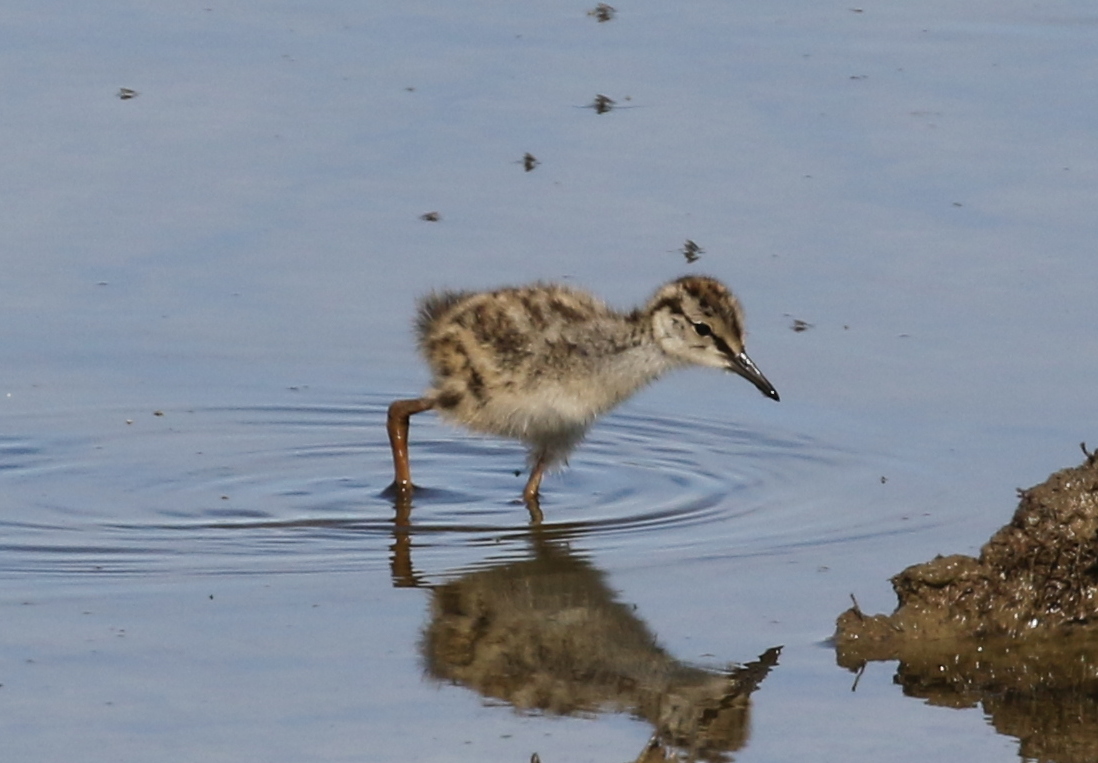 Redshank – one of several juveniles around the Serpentine
Redshank – one of several juveniles around the Serpentine
As there has been over the last few weeks, there was a nice selection of wildfowl around the Serpentine, even if the drakes are starting to moult into eclipse plumage. As well as the usual Mallard and Gadwall, including a nice little family party of the latter with several small ducklings, there were also two Wigeon and quite a few Teal, both species which are more winter visitors. How many of these have remained here all summer, and how many have been around either here or nearby right the way through, is hard to tell. There were loads of Greylag Geese too, with no shortage of young ones with them, already well grown now.
There was quite a fresh breeze blowing in, with the wind having turned north-east this afternoon. The Sand Martins seemed to be enjoying it. There was quite a flock of them, hawking for insects. They kept swinging out over the marshes, before returning en masse and swooping around the bank.
 Sand Martin – a large flock were hawking for insects around the East Bank
Sand Martin – a large flock were hawking for insects around the East Bank
We had hoped we might find a Bearded Tit along here, but it was perhaps a bit too windy to get a good look at one. We did hear some calling. One was in the reeds in the ditch on the east side of the bank. The light was perfect this side, although it was most exposed to the wind. We stood close by hoping it would climb up into the reeds but unfortunately it flew off down the line of the reeds. There were quite a few Reed Warblers, which showed quite well, and a male Reed Bunting perched in the top of the reeds singing.
There were quite a few Sandwich Terns on Arnold’s Marsh, and plenty of Great Black-backed Gulls, but not much else of note today. We were told there had been a Little Gull offshore here, but by the time we got out to the beach it had moved on. There were lots of Sandwich Terns offshore, as well as a single adult Mediterranean Gull with the Black-headed Gulls.
There were more waders moving, to add to the Whimbrel we had seen earlier. A single Curlew flew west over Arnold’s Marsh, flying straight through without stopping. Then while we were looking out to see, we noticed three more Curlews flying west just offshore, presumably just arriving fresh in from the Continent. More waders on migration, which is always interesting to see.
 Curlew – these three were probably just arriving from the Continent this afternoon
Curlew – these three were probably just arriving from the Continent this afternoon
We had an appointment with Nightjars this evening, so with an eye on the clock and the need to get something to eat beforehand we headed back to the car. A Little Ringed Plover flew off from the Serpentine as we passed, presumably having dropped in while we were at the beach.
Having had a break and eaten, we met up again later in the evening. We were just looking for Nightjars this evening, so we made our way straight up to the heath. We arrived in good time and with a few minutes to spare, we had a quick walk round looking for some good places to stand.
As we walked past a clump of gorse, we heard a very soft churr which meant that a Nightjar was very close. Peering over the vegetation, we could just see it through a narrow gap, perched on a branch lying on the ground. Unfortunately, as we tried to get everyone up onto it, it took off. We had a nice flight view as it flew round and up into some trees. It was a male – we could see the white corners to its tail and white bands across the tips of its wings as it flew. We saw roughly where it went, so we walked over in the direction.
The Nightjar hadn’t landed on one of its regular perches. It was now about time for them to start churring anyway, and it duly obliged by bursting into ‘song’. We could hear where it was, a bit further along than normal, so we made our way carefully round the trees. It was perched right out in the open on a dead branch, but again we struggled to get everyone onto it before it flew. They never stay in one place for long, especially early in the evening. As it took off, a second male Nightjar joined it, and the two of them circled up over the edge of the trees calling. This is a territorial boundary, so there was probably a bit of a discussion going on!
We followed one of the two male Nightjars as it flew off across the Heath. We know exactly where it likes to perch, so it was just a matter of which tree it might head for. At first it was not settling and we quickly realised why – there was a female Nightjar there too! The male flew after her, following her from branch to branch, wing-clapping. The female was much harder to follow in the gloom, lacking the male’s white wing and tail patches.
When the female Nightjar flew on again, this time the male remained perched and gave us a chance to get it in the scope. It stayed there churring for a minute or two. There was still just enough light to get a really good look at it – and some photos. Great stuff!
 Nightjar – this male eventually settled and started churring
Nightjar – this male eventually settled and started churring
When that male Nightjar finally flew again, we could hear a different bird churring across the Heath. We looked across and it was perched in a tree, perfectly silhouetted against the last of the light, a classic Nightjar view. When it finally moved away, we decided to head back.
The light was fading fast now and we had already enjoyed some unforgettable Nightjar views, so we decided to call it a night. They really are the most fascinating of birds and there is nothing better than standing on a heath on a summer’s evening listening to them churring and watching them flying round. It is always a great way to end a day of Summer birding.




